An Active Service Recommendation Model for Multi-Source Remote Sensing Information Using Fusion of Attention and Multi-Perspective
Abstract
1. Introduction
1.1. Research Background
1.2. Contributions
- We optimize the remote sensing information evaluation method by modeling and analyzing actual metrics in user behaviors, remote sensing data and remote sensing services, and reduce the impact on remote sensing resource representation from the uncertainty of the cloud environment and mutual independence of disciplinary domains.
- We put forward a series of targeted heuristic policies to support remote sensing information discovery, which optimizes the value assessment results from multi-perspectives, and meet the demands for remote sensing resources in different domains and groups.
- We innovatively put forward a recommendation model, which based on the attention mechanism, fuses different resource discovery policies into the deep collaborative filtering technology to upgrade the “foresight” ability of the remote sensing information system platform.
1.3. Paper Organization
2. Related Work
3. Proposed Methodology
3.1. Problem Formulation
3.2. Value Evaluation of Remote Sensing Information from Multi-Perspective
3.2.1. User Value Evaluation Function
- Behavior information model of remote sensing users
- 2.
- Division and association of remote sensing users
| Algorithm 1 Division and Association of Remote Sensing Users |
| INPUT: the user attribute set , the number of groups ; OUTPUT: the user group ; |
|
- 3.
- Value evaluation function of remote sensing users
3.2.2. Data Value Evaluation Function
3.2.3. Service Value Evaluation Function
3.3. Recommendation Model of Multi-Source Remote Sensing Information
3.3.1. Definition of Heuristic Policies to Support Resource Discovery
- User interest value policy (ST1)
- 2.
- Expert value policy (ST2)
- 3.
- Domain value policy (ST3)
3.3.2. Recommendation Algorithm of Multi-Source Remote Sensing Information
- Design of feature space
| Algorithm 2 Recall of Remote Sensing Resources Based on Heuristic Polices |
| INPUT: the user set , the user grouping matrix G, the number of recalled resources , , ; OUTPUT: the recalled resource set ; |
|
- Design of value policy fusion
- Design of network output
| Algorithm 3 MRS_AMRA |
| INPUT: the user set , the resource set D, the number of recalled resources , , , and the number of recommended resources ; OUTPUT: the recommended resource set ; |
|
3.3.3. The Implementation of Recommendation Algorithm
4. Experiments
4.1. Experimental Setting
- The WS-DREAM dataset
- The remote sensing resource dataset
4.2. Experimental Results
4.2.1. Performance Experiment of Recommendation Algorithm
4.2.2. Availability Experiment of Recommendation Model
5. Conclusions
Author Contributions
Funding
Data Availability Statement
Conflicts of Interest
References
- Li, D.R.; Ding, L.; Shao, Z.F. Application-oriented real-time remote sensing service technology. Natl. Remote Sens. Bull. 2020, 25, 15–24. [Google Scholar]
- Long, E.; Lü, S.Y.; Cen, P.R.; Yang, Y.; Weir, E.; Bai, L. An intelligent recommendation method of multi-source remote sensing information considering user portrait. Acta Geod. Cartogr. Sin. 2022, 52, 297–306. [Google Scholar]
- Zheng, Z.; Ma, H.; Lyu, M.R.; King, I. QoS-aware web service recommendation by collaborative filtering. IEEE Trans. Serv. Comput. 2011, 4, 140–152. [Google Scholar] [CrossRef]
- Tang, M.; Jiang, Y.; Liu, J.; Liu, X. Location-aware collaborative filtering for qos-based service recommendation. In Proceedings of the 19th International Conference Web Services (ICWS’12), Honolulu, HI, USA, 24–29 June 2012; pp. 202–209. [Google Scholar]
- Chelliah, B.J.; Vivekanandan, K. Location-aware collaborative filtering for web service recommendations based on user and service history. J. Eng. Sci. Technol. Rev. 2017, 10, 190–194. [Google Scholar] [CrossRef]
- Peng, Q.; You, L.; Dong, N. A location-aware GIServices quality prediction model via collaborative filtering. Int. J. Remote Sens. Inf. Syst. 2018, 11, 897–912. [Google Scholar] [CrossRef]
- Yao, L.; Sheng, Q.Z.; Ngu, A.H.H.; Yu, J.; Segev, A. Unified collaborative and content-based web service recommendation. IEEE Trans. Serv. Comput. 2015, 8, 453–466. [Google Scholar] [CrossRef]
- Sangers, J.; Frasincar, F.; Hogenboom, F.; Chepegin, V. Semantic web service discovery using natural language processing techniques. Expert Syst. Appl. 2013, 40, 4660–4671. [Google Scholar] [CrossRef]
- Paul, M.; Ghosh, S.K. Toward assessing semantic similarity of geospatial services. In Proceedings of the Tencon IEEE Region 10 Conference, Hong Kong, China, 14–17 November 2006; pp. 1–4. [Google Scholar]
- Bener, A.B.; Ozadali, V.; Ilhan, E.S. Semantic matchmaker with precondition and effect matching using SWRL. Expert Syst. Appl. 2009, 36, 9371–9377. [Google Scholar] [CrossRef]
- Luo, A.; Wang, Y.; Wang, L.; He, Y. Multi-level semantic matching of geospatial web services. In Proceedings of the 2009 17th International Conference on Geoinformatics, Fairfax, Virginia, 12–14 August 2009; pp. 1–5. [Google Scholar]
- Wu, Q.Y.; Zheng, X.M.; Kang, L.J. A semantic geospatial service matching algorithm. In Proceedings of the The 2nd International Conference on Information Science and Engineering, Hangzhou, China, 4–6 December 2010; pp. 3475–3478. [Google Scholar]
- Dareshiri, S.; Farnaghi, M.; Sahelgozin, M. A recommender geoportal for geospatial resource discovery and recommendation. J. Spat. Sci. 2019, 64, 49–71. [Google Scholar] [CrossRef]
- Lai, J.B.; Kang, X.D.; Lu, X.K.; Li, S.T. A review of land observation satellite remote sensing application technology with new generation artificial intelligence. Natl. Remote Sens. Bull. 2022, 26, 1530–1546. [Google Scholar]
- Yan, K.; Chen, H.M.; Fu, D.J.; Zeng, Y.L.; Dong, J.W.; Li, S.W.; Wu, Q.S.; Li, H.L.; Du, S.Y. Bibliometric visualization analysis related to remote sensing cloud computing platforms. Natl. Remote Sens. Bull. 2022, 26, 310–323. [Google Scholar]
- Li, D.R.; Zhang, L.P.; Xia, G.S. Automatic analysis and mining of remote sensing big data. Acta Geod. Cartogr. Sin. 2014, 43, 1211–1216. [Google Scholar]
- Fu, K.; Sun, X.; Qiu, X.L. Multi-satellite integrated processing and analysis method under remote sensing big data. Natl. Remote Sens. Bull. 2021, 25, 691–707. [Google Scholar]
- Fu, D.J.; Xiao, H.; Su, F.Z.; Zhou, C.H.; Dong, J.W.; Zeng, Y.L.; Yan, K.; Li, S.W.; Wu, J.; Wu, W.Z.; et al. Remote sensing cloud computing platform development and Earth science application. Natl. Remote Sens. Bull. 2021, 25, 220–230. [Google Scholar]
- Liu, W.Q.; Wang, C.; Zang, Y.; Hu, Q.; Yu, S.S.; Lai, B.Q. A survey on information extraction technology based on remote sensing big data. Big Data Res. 2022, 14, 28–57. [Google Scholar]
- Geng, Y.; Tao, C.; Shen, J.; Zou, Z. High-resolution remote sensing image semantic segmentation based on semi-supervised full convolution network method. Geod. Cartogr. Sin. 2020, 49, 499–508. [Google Scholar]
- Ge, Y.; Ma, L.; Chu, J. Remote sensing image retrieval combining discriminant correlation analysis and feature fusion. J. Image Graph. 2020, 25, 2665–2676. [Google Scholar]
- Chen, W.T.; Te, R.G. Research on retrieval of remote sensing data service system based on PostGIS. Geomat. Spat. Inf. Technol. 2021, 44, 78–83. [Google Scholar]
- Li, S.Y.; Zhang, W.F.; Yang, S. Intelligence fusion method research of multisource high-resolution remote sensing images. J. Remote Sens. 2017, 21, 415–424. [Google Scholar]
- Hu, T.Y.; Zhao, D.; Zeng, Y.; Guo, Q.H.; He, H.L. Advances in multi⁃source data fusion for ecosystem assessment. Acta Ecol. Sin. 2023, 43, 542–553. [Google Scholar]
- Zhang, J.X.; Gu, H.Y.; Yang, Y.; Zhang, H.; Li, H.T. Research progress and trend of high-resolution remote sensing imagery intelligent interpretation. Natl. Remote Sens. Bull. 2021, 25, 2198–2210. [Google Scholar]
- Zhang, B.; Yang, X.M.; Gao, L.R.; Meng, Y.; Sun, X.; Xiao, C.; Ni, L. Geo-cognitive models and methods for intelligent interpretation of remotely sensed big data. Acta Geod. Cartogr. Sin. 2022, 51, 1398–1415. [Google Scholar]
- Chen, X.; Liu, Y.; Li, F.; Li, X.; Jia, X. Remote sensing image recommendation based on spatial–temporal embedding topic model. Comput. Geosci. 2022, 157, 104935–104946. [Google Scholar] [CrossRef]
- Hu, L.; Zhang, C.; Zhang, M.; Shi, Y.; Lu, J.; Fang, Z. Enhancing FAIR data services in agricultural disaster: A review. Remote Sens. 2023, 15, 2024. [Google Scholar] [CrossRef]
- Li, J.; Pei, Y.; Zhao, S.; Xiao, R.; Sang, X.; Zhang, C. A review of remote sensing for environmental monitoring in China. Remote Sens. 2020, 12, 1130. [Google Scholar] [CrossRef]
- Li, G.Q.; Huang, Z.C. Data infrastructure for remote sensing big data: Integration, management and on-demand service. J. Comput. Res. Dev. 2017, 54, 267–283. [Google Scholar]
- Shen, L.; Xu, Z.; Li, Z.L.; Liu, W.Z.; Cui, B.L. From geographic information service to geographic knowledge service: Research problems and development roadmap. J. Surv. Mapp. 2021, 50, 1194–1202. [Google Scholar]
- Zhang, X.W.; He, K.Q.; Wang, J.; Liu, J.X. A Survey of Web Service Personalized Recommendation Research. Comput. Eng. Sci. 2013, 35, 132–140. [Google Scholar]
- Tian, H.; Liang, P. Personalized service recommendation based on trust relationship. Sci. Program. 2017, 2017, 4106134. [Google Scholar] [CrossRef]
- Gonsalves, B.; Patil, V. LoQoS location and QoS sensitive web service recommender. In Proceedings of the 2017 International Conference on Innovations in Information, Embedded and Communication Systems (ICIIECS), Beijing, China, 24–26 June 2017; pp. 1–4. [Google Scholar]
- Hong, J.H.; Su, Z.L.T.; Lu, E.H.C. A recommendation framework for remote sensing images by spatial relation analysis. J. Syst. Softw. 2014, 90, 151–166. [Google Scholar] [CrossRef]
- Zhang, X.; Chen, D.; Liu, J. A space-time periodic task model for recommendation of remote sensing images. ISPRS Int. J. Geo-Inf. 2018, 7, 40. [Google Scholar] [CrossRef]
- Liu, Y.M. Fundamentals of Statistics; China Statistics Press: Beijing, China, 2002. [Google Scholar]
- Raftery, A.E.; Madigan, D.; Hoeting, J.A. Bayesian model averaging for linear regression models. J. Am. Stat. Assoc. 1997, 92, 179–191. [Google Scholar] [CrossRef]
- Papathanasiou, J.; Ploskas, N. Topsis. In Multiple Criteria Decision Aid; Springer: Cham, Switzerland, 2018. [Google Scholar]
- Zhou, G.; Zhu, X.; Song, C.; Fan, Y.; Zhu, H.; Ma, X.; Yan, Y.; Jin, J.; Li, H.; Gai, K. Deep interest network for click-through rate prediction. In Proceedings of the 24th ACM SIGKDD International Conference on Knowledge Discovery & Data Mining, London, UK, 19–23 August 2018; pp. 1059–1068. [Google Scholar]
- He, X.; Liao, L.; Zhang, H.; Nie, L.; Hu, X.; Chua, T.S. Neural collaborative filtering. In Proceedings of the 26th International Conference on World Wide Web, Perth, Australia, 3–7 April 2017; pp. 173–182. [Google Scholar]
- Lu, Z. Research and Implementation of Distributed cloud Push System Based on Websocket Protocol; Dalian University of Technology: Dalian, China, 2019. [Google Scholar]
- Zheng, Z.; Zhang, Y.; Lyu, M.R. Investigating QoS of real-world web services. IEEE Trans. Serv. Comput. 2012, 7, 32–39. [Google Scholar] [CrossRef]
- Wang, M.; Song, T. Remote sensing image retrieval by scene semantic matching. IEEE Trans. Geosci. Remote Sens. 2012, 51, 2874–2886. [Google Scholar] [CrossRef]
- Hu, Z.H.; Meng, L.K.; Zhang, W. Research on subscribe /publish mechanism for incremental data in GIS. Bull. Surv. Mapp. 2016, 1, 45–48. [Google Scholar]
- Yan, L.; Ahmad, M.W.; Jawarneh, M.; Shabaz, M.; Raffik, R.; Kishore, K.H. Single-input single-output system with multiple time delay PID control methods for UAV cluster multiagent system. Secur. Commun. Netw. 2022, 2022, 3935143. [Google Scholar] [CrossRef]
- Gao, H.; Kareem, A.; Jawarneh, M.; Ofori, I.; Raffik, R.; Kishore, K.H. Metaheuristics based modeling and simulation analysis of new integrated mechanized operation solution and position servo system. Math. Probl. Eng. 2022, 2022, 1466775. [Google Scholar] [CrossRef]

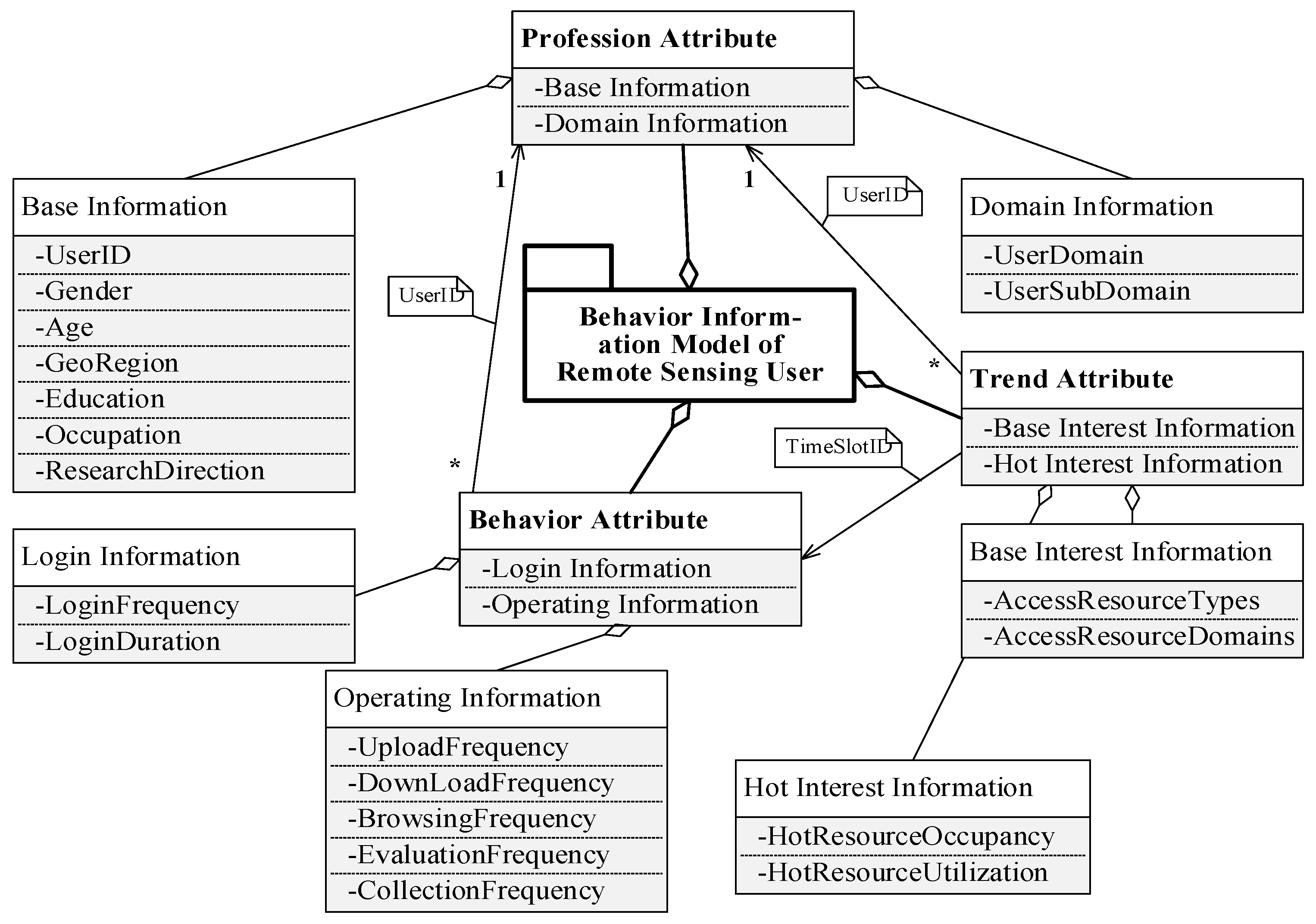
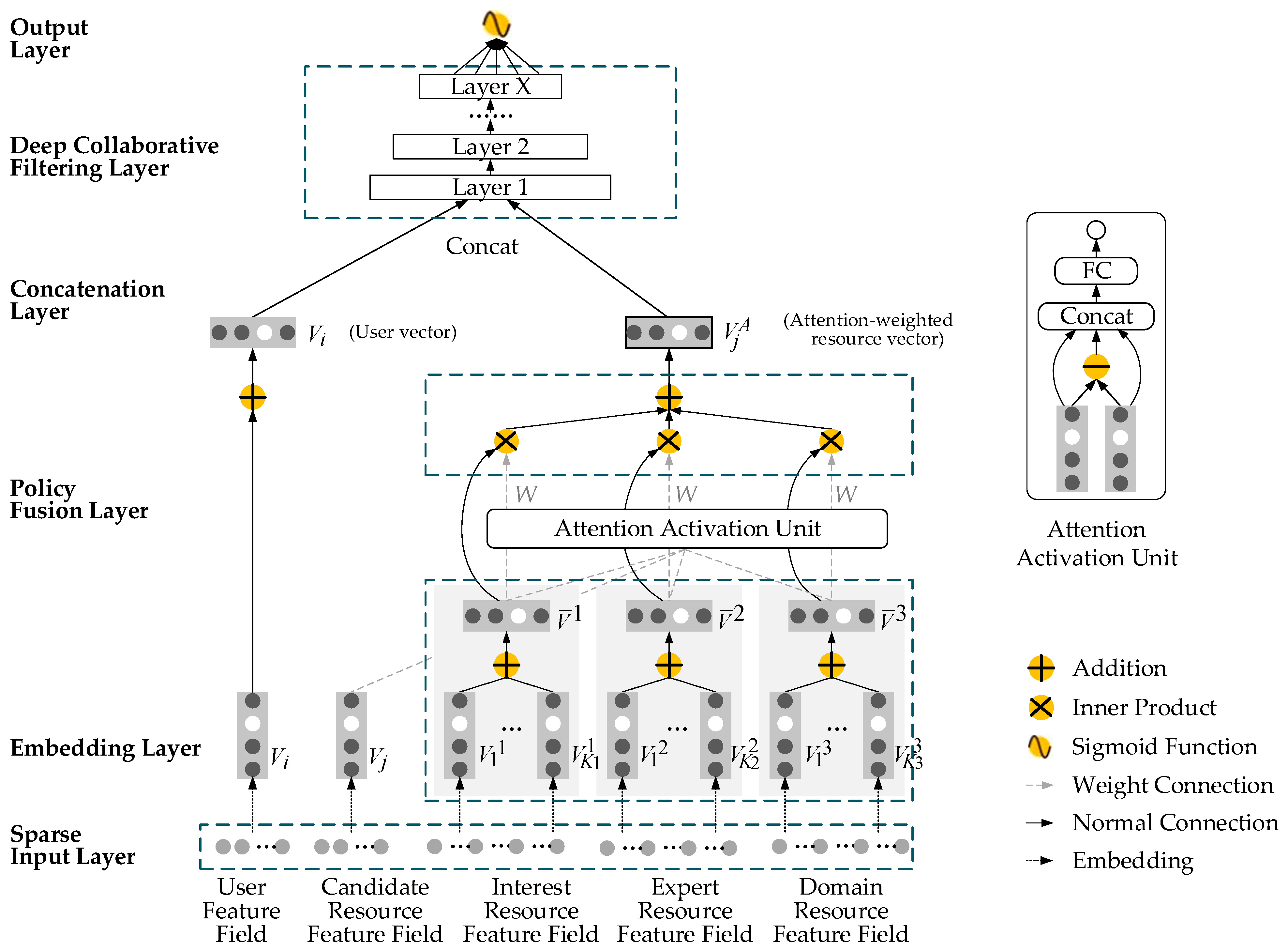
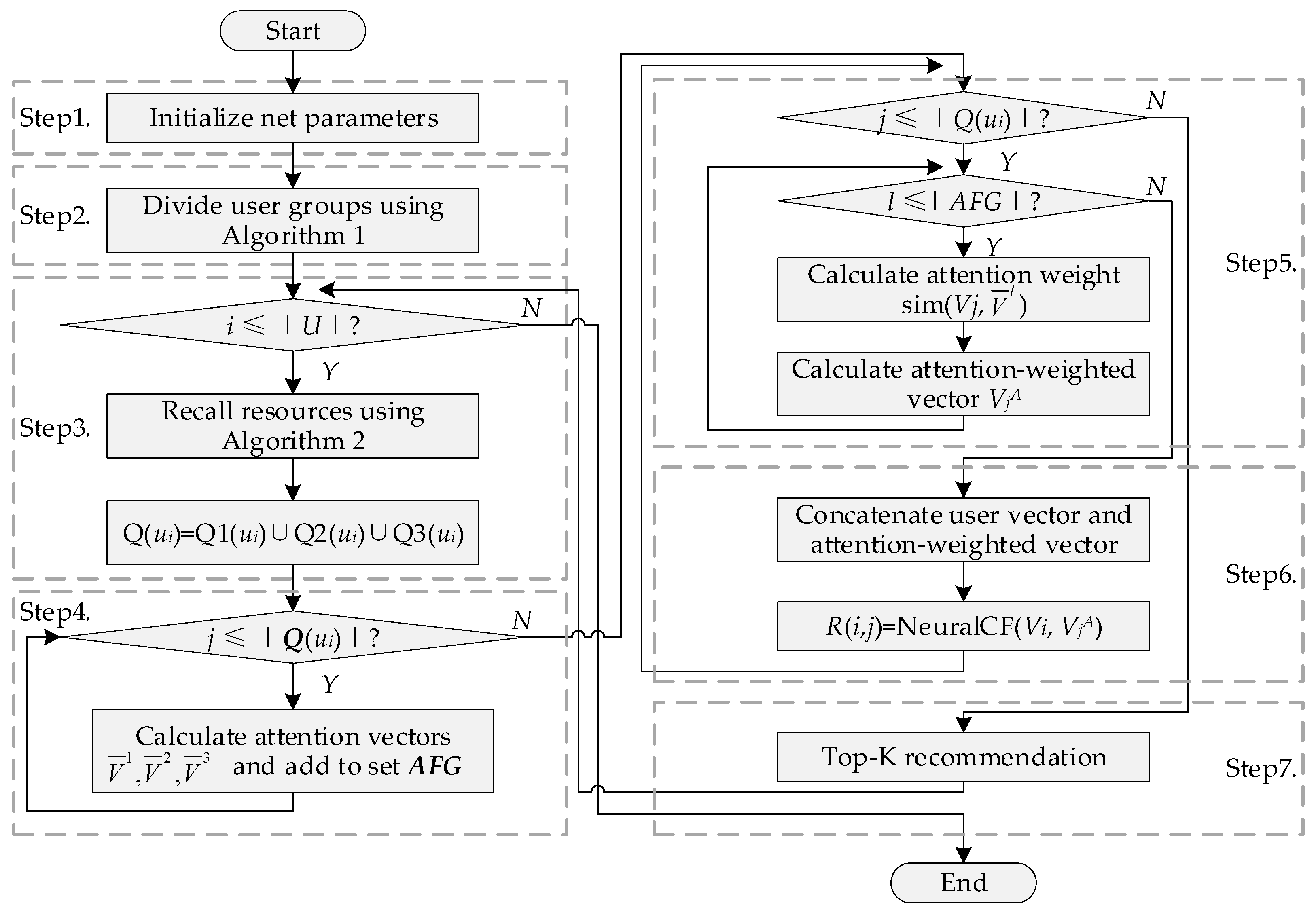
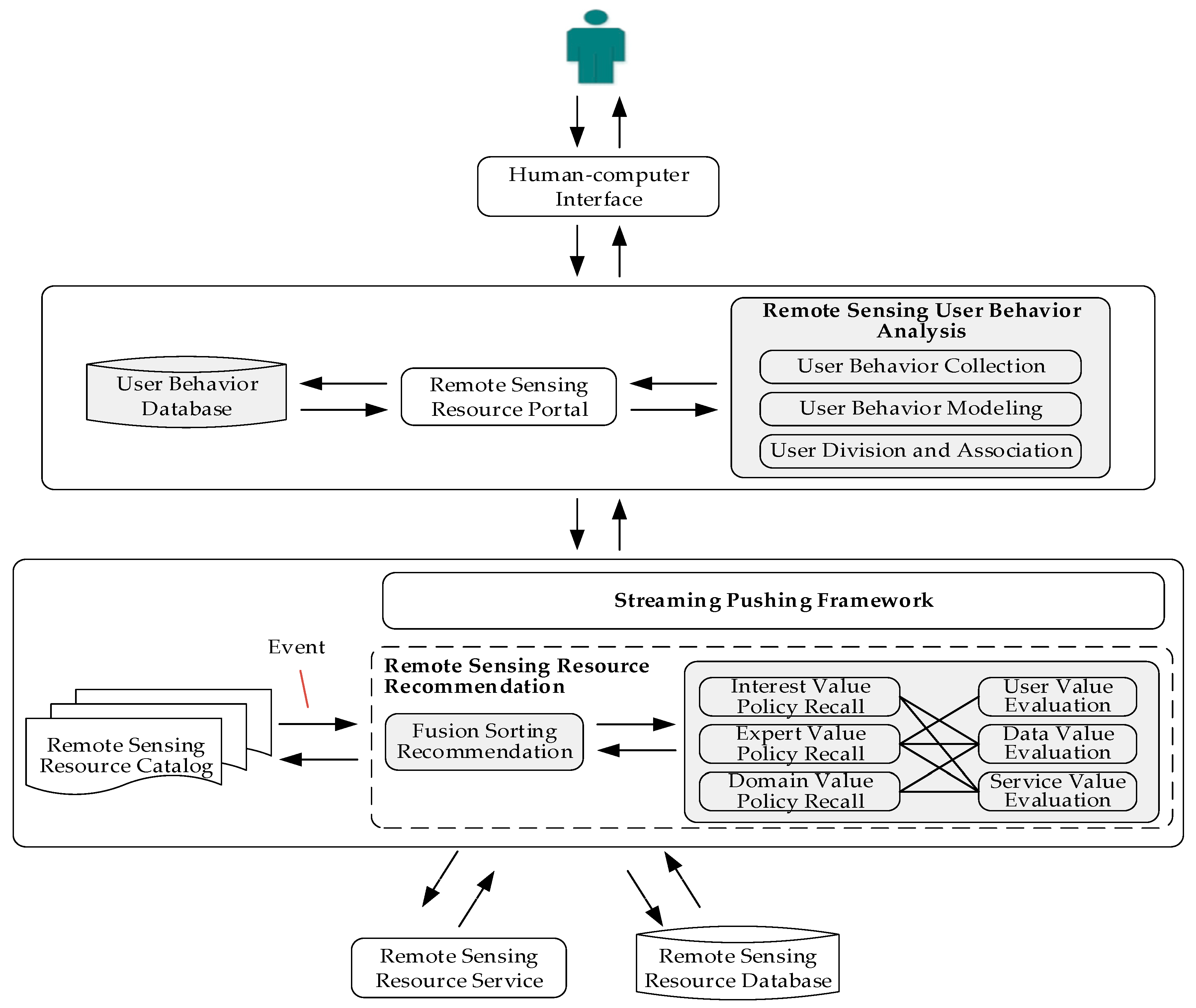
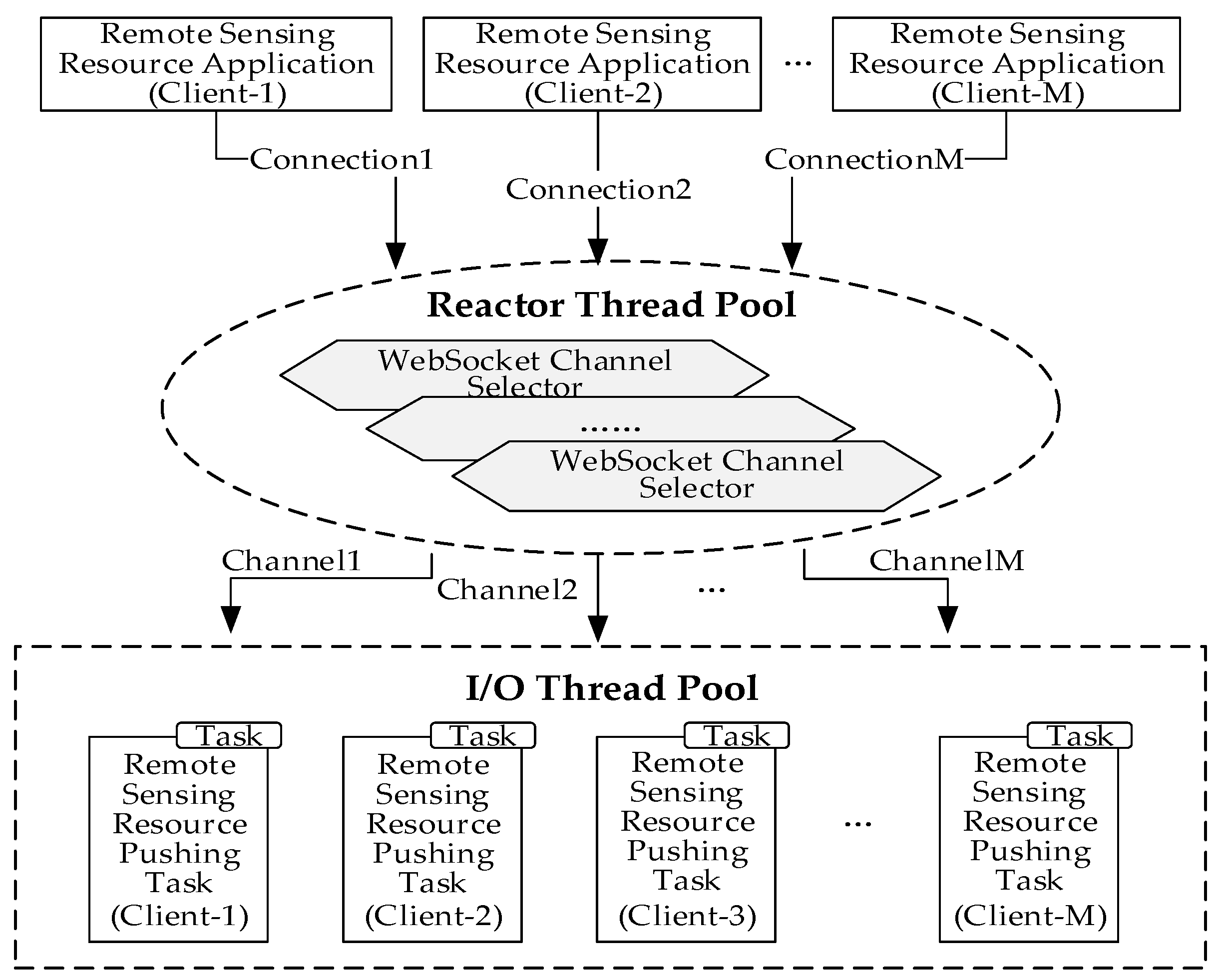
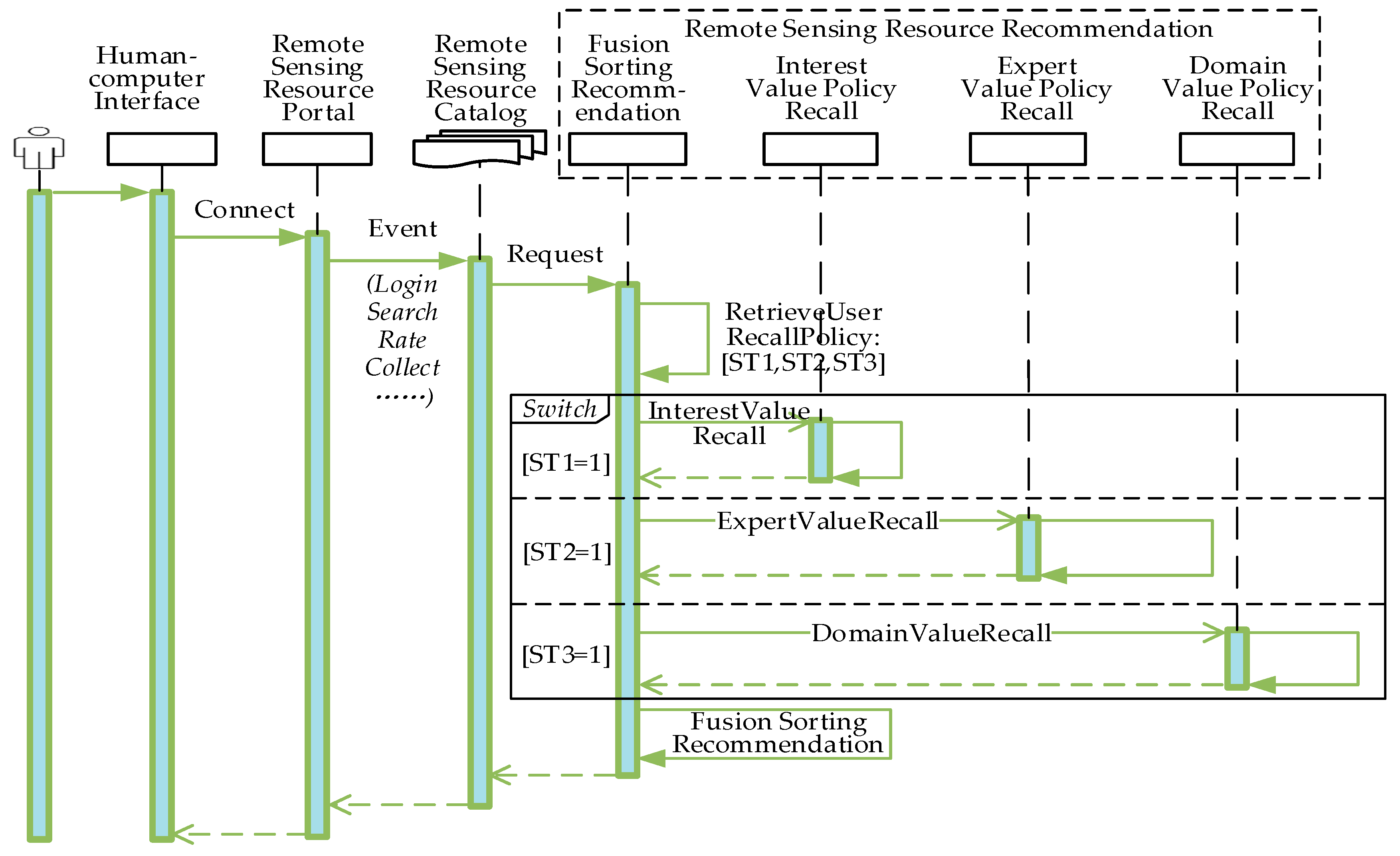
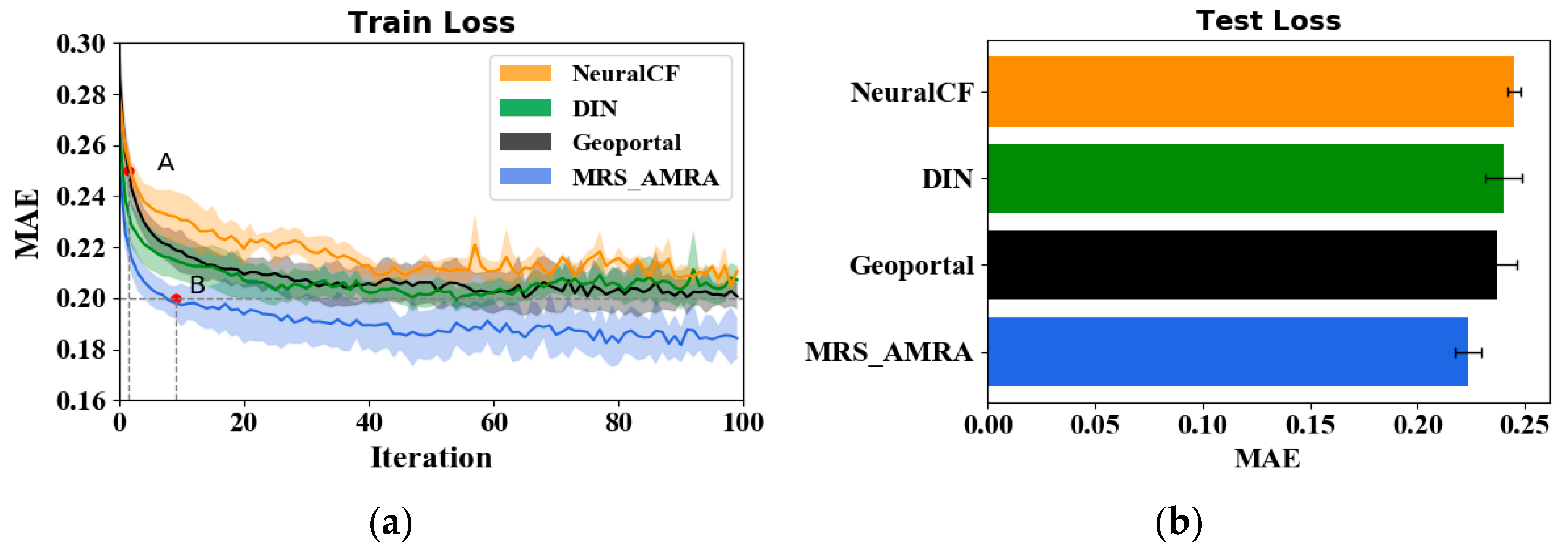
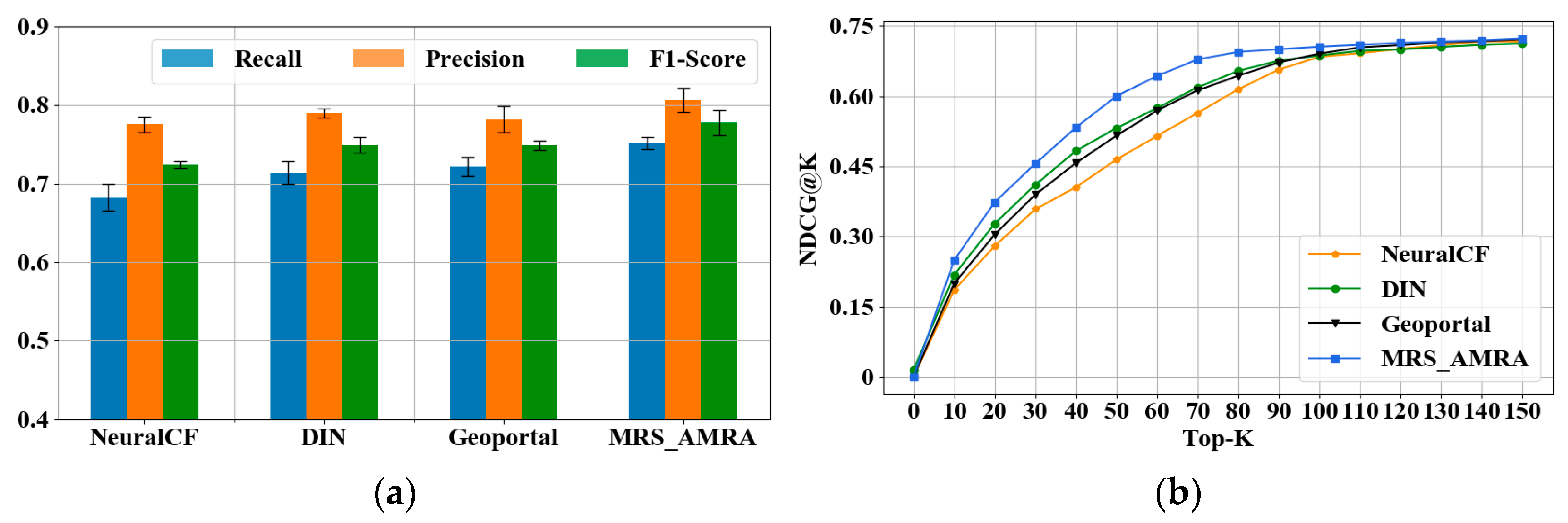
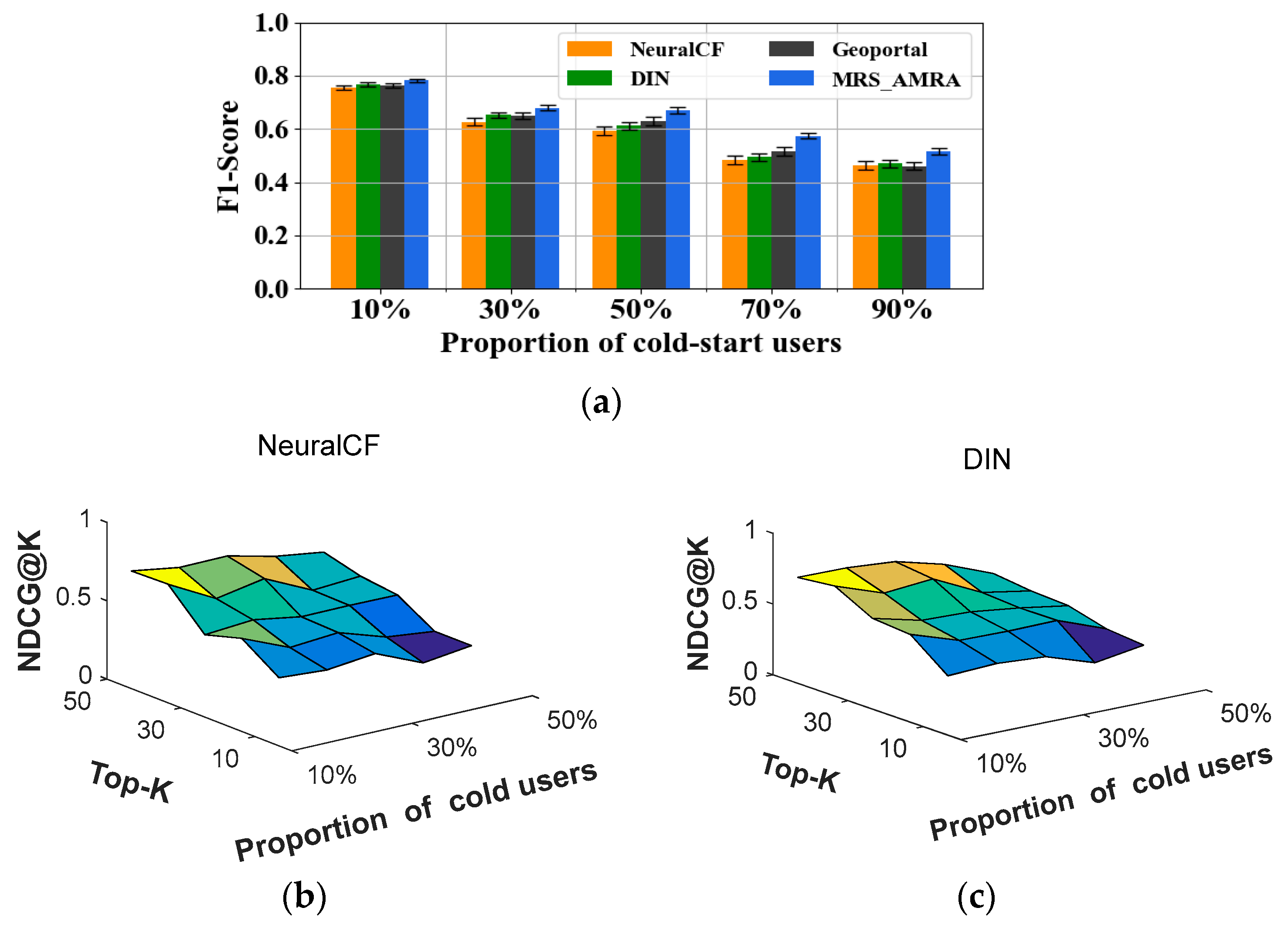
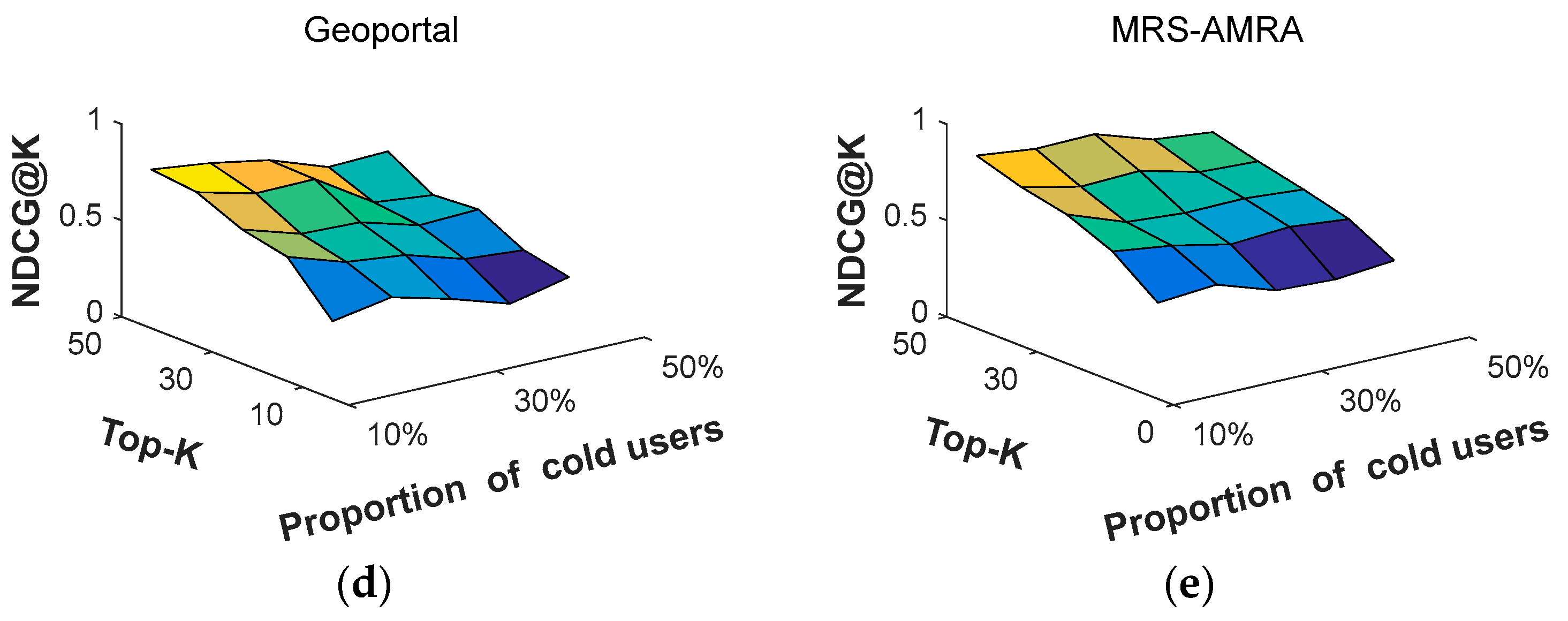


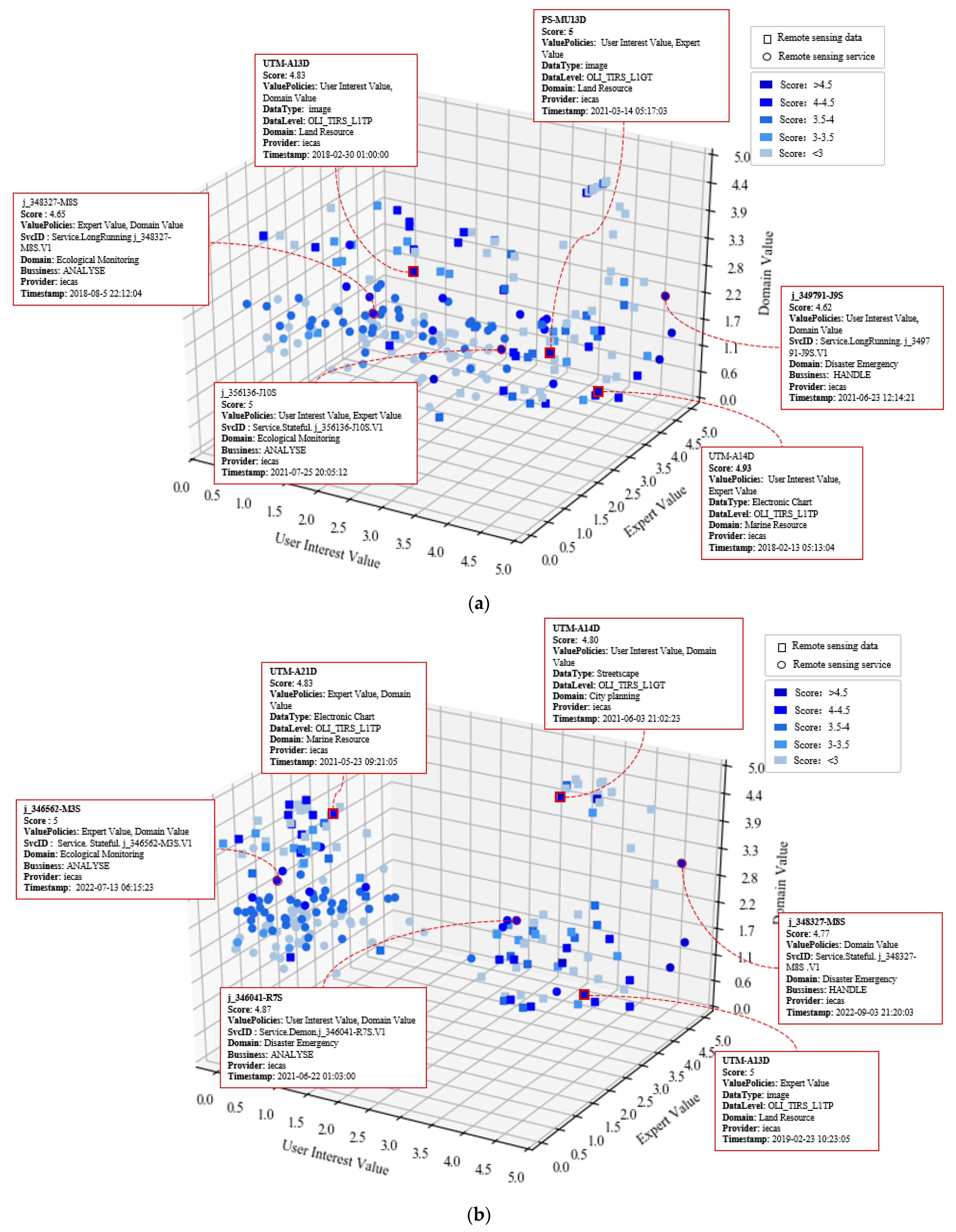
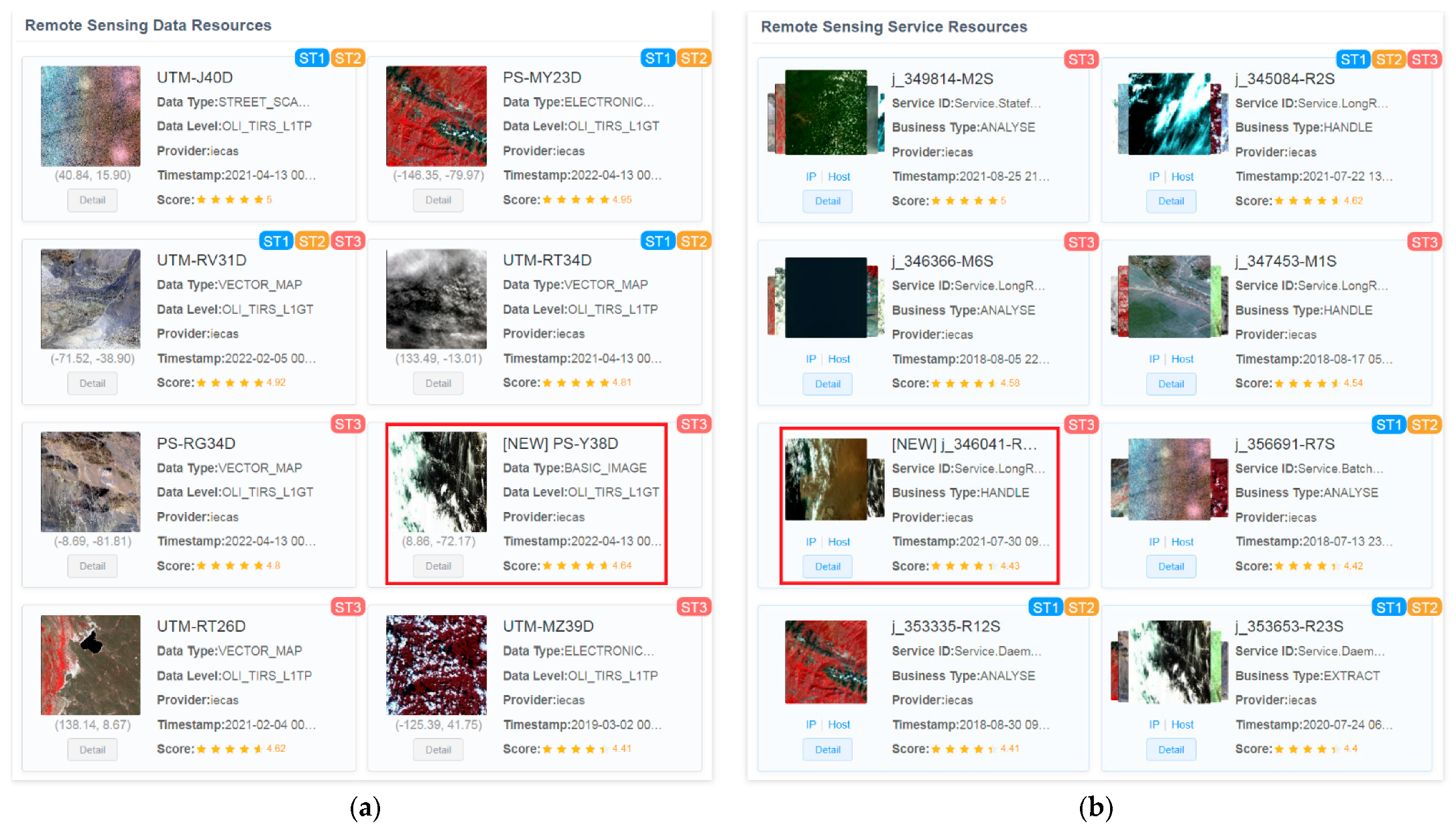
| UA Segmentation | Value Level | SF Segmentation | Value Level | UC Segmentation | Value Level |
|---|---|---|---|---|---|
| … | … | … | … | … | … |
| Categories | Features | Attributes | Description |
|---|---|---|---|
| User | Basic Feature | UserID | User’s identification |
| Gender | User’s gender | ||
| Age | User’s age | ||
| GeoRegion | User’s geographical region | ||
| Education | User’s education background | ||
| Occupation | User’s occupation | ||
| ResearchDirection | User’s research direction | ||
| Domain Feature | UserDomain | User’s domain | |
| UserSubDomain | User’s sub-domain | ||
| Resource | Data Feature | SatelliteCode | Satellite identification of remote sensing data |
| SensorCode | Sensor identification of remote sensing data | ||
| ShootingTime | Shooting time of remote sensing data | ||
| ProductionTime | Production time of remote sensing data | ||
| ReferenceSystem | Reference system of remote sensing data | ||
| SpatialResolution | Spatial resolution of remote sensing data | ||
| DataCategory | Category of remote sensing data | ||
| DataFormat | Format of remote sensing data | ||
| Service Feature | SvcID | Identification of remote sensing service | |
| SvcResponseTime | Response time of remote sensing service | ||
| SvcThroughput | Throughput of remote sensing service | ||
| SvcErrorRate | Request error rate of remote sensing service | ||
| SLAViolationRate | SLA violation rate of remote sensing service |
| Statistics | Value |
|---|---|
| Num. of Web Service Invocations | 1,974,675 |
| Num. of Service Users | 339 |
| Num. of Web Services | 5825 |
| Num. of User Countries | 30 |
| Num. of Web Service Countries | 73 |
| Mean of Response-Time | 1.43 s |
| Standard Deviation of Response-Time | 31.9 s |
| Mean of Throughput | 102.86 kbps |
| Standard Deviation of Throughput | 531.85 kbps |
| Comparison Items | Active Service Recommendation Model | Content-Based Retrieval Method [44] | Subscription-Based Retrieval Method [45] |
|---|---|---|---|
| Service mode | Proactive | Passive | Semi-active |
| User satisfaction | Satisfied | Not very satisfied | Not very satisfied |
| Count of interactions | 207 | 523 | 336 |
| System interaction time | 93 s | 13.2 min | 7.1 min |
| Average query time | 0.37 s | 1.08 s | 0.85 s |
| Total query time | 78 s | 9.4 min | 4.8 min |
Disclaimer/Publisher’s Note: The statements, opinions and data contained in all publications are solely those of the individual author(s) and contributor(s) and not of MDPI and/or the editor(s). MDPI and/or the editor(s) disclaim responsibility for any injury to people or property resulting from any ideas, methods, instructions or products referred to in the content. |
© 2023 by the authors. Licensee MDPI, Basel, Switzerland. This article is an open access article distributed under the terms and conditions of the Creative Commons Attribution (CC BY) license (https://creativecommons.org/licenses/by/4.0/).
Share and Cite
Zhu, L.; Wu, F.; Fu, K.; Hu, Y.; Wang, Y.; Tian, X.; Huang, K. An Active Service Recommendation Model for Multi-Source Remote Sensing Information Using Fusion of Attention and Multi-Perspective. Remote Sens. 2023, 15, 2564. https://doi.org/10.3390/rs15102564
Zhu L, Wu F, Fu K, Hu Y, Wang Y, Tian X, Huang K. An Active Service Recommendation Model for Multi-Source Remote Sensing Information Using Fusion of Attention and Multi-Perspective. Remote Sensing. 2023; 15(10):2564. https://doi.org/10.3390/rs15102564
Chicago/Turabian StyleZhu, Lilu, Feng Wu, Kun Fu, Yanfeng Hu, Yang Wang, Xinmei Tian, and Kai Huang. 2023. "An Active Service Recommendation Model for Multi-Source Remote Sensing Information Using Fusion of Attention and Multi-Perspective" Remote Sensing 15, no. 10: 2564. https://doi.org/10.3390/rs15102564
APA StyleZhu, L., Wu, F., Fu, K., Hu, Y., Wang, Y., Tian, X., & Huang, K. (2023). An Active Service Recommendation Model for Multi-Source Remote Sensing Information Using Fusion of Attention and Multi-Perspective. Remote Sensing, 15(10), 2564. https://doi.org/10.3390/rs15102564







